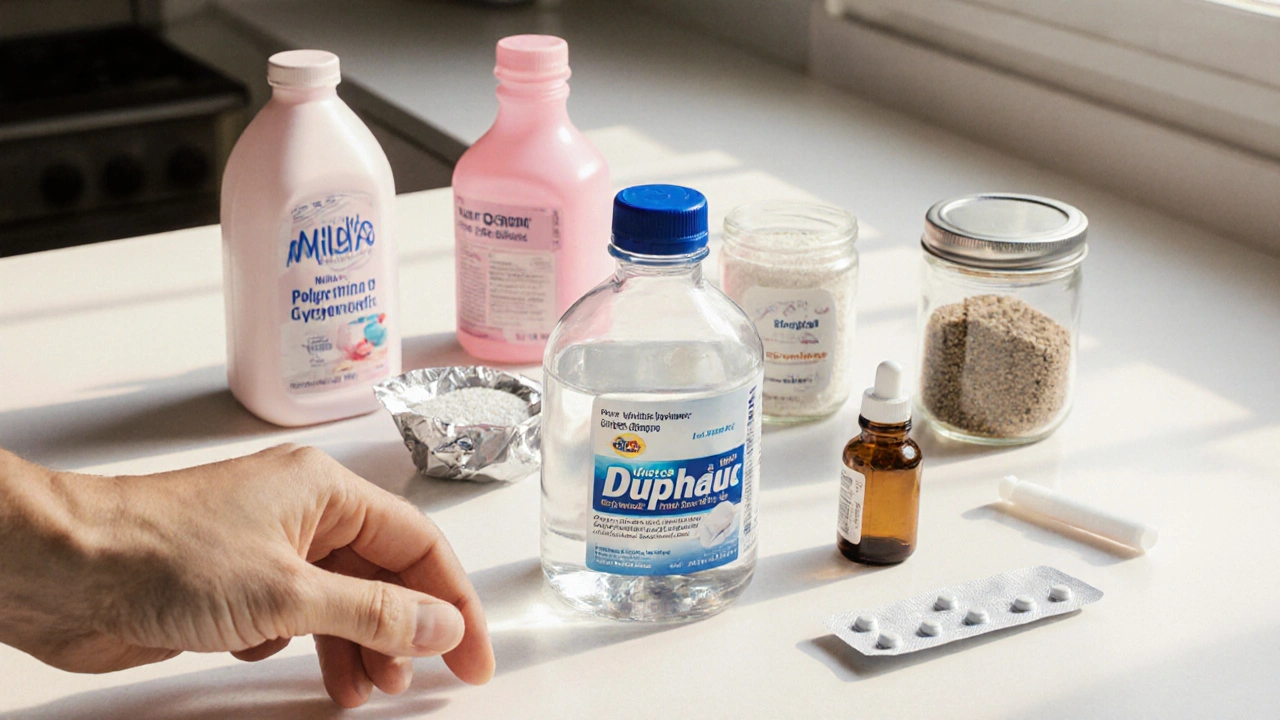lactulose alternatives: practical choices for gut health and liver care
When working with lactulose alternatives, non‑prescription or prescription laxatives that can replace lactulose for bowel‑cleansing and hepatic encephalopathy management. Also known as lactulose substitutes, they offer different mechanisms, side‑effect profiles and price points.
The classic drug lactulose, a synthetic disaccharide that draws water into the colon and reduces ammonia absorption has been a go‑to for both constipation and liver‑related brain symptoms. However, many patients look for lactulose alternatives because they want faster relief, fewer gas bursts, or a lower cost. The most common switch is to an osmotic agent like polyethylene glycol, a polymer that holds water in the stool and works without fermenting into gas. PEG‑based products (PEG 3350, MiraLAX) are over‑the‑counter, cheap and have a gentle taste, making them popular in households and nursing homes.
Another widely used substitute is magnesium hydroxide, an antacid‑laxative that increases intestinal water and stimulates peristalsis. It doubles as a heartburn reliever, which can be handy for people juggling both reflux and constipation. For those who prefer mineral‑based options, magnesium citrate, a highly absorbable form that works fast for bowel prep is a strong contender, especially before endoscopic procedures.
Choosing the right alternative – what matters most?
Three key factors shape the decision: mechanism of action, side‑effect profile, and cost. The mechanism tells you how the drug clears the colon. Osmotic agents (PEG, sorbitol, lactitol) pull water in, while stimulant laxatives like senna, a plant‑derived compound that triggers colonic contractions boost muscle activity. Understanding this helps you avoid mixing agents that could cause cramping or electrolyte loss.
Side‑effects differ dramatically. PEG rarely causes gas, but high doses can lead to dehydration if fluid isn’t replenished. Magnesium‑based pills may cause loose stools and, in kidney‑impaired patients, dangerously high magnesium levels. Senna, on the other hand, is notorious for abdominal cramps and can cause dependency if used long term. Matching the side‑effect profile to a patient’s tolerance is a core step in safe substitution.
Cost and accessibility often tip the scales. Over‑the‑counter PEG and magnesium products usually cost less than a prescription lactulose bottle, especially when bought in bulk. Online pharmacy guides—like the ones that explain how to buy cheap generic medications safely—show that price checks and pharmacy verification can shave off 30‑40 % of the usual expense. This mirrors the trend across many medication‑comparison articles that stress the importance of price transparency.
For liver patients, the decision carries extra weight. Lactulose reduces ammonia by converting it to ammonium, which cannot cross the blood‑brain barrier. Some alternatives, like rifaximin, target gut bacteria directly and are often paired with a laxative for best results. While rinsing the gut with PEG won’t lower ammonia as effectively, it can still ease constipation, which indirectly helps reduce ammonia production. Therefore, many clinicians combine a mild osmotic laxative with a low‑dose antibiotic for a balanced approach.
Dosage guidance also varies. PEG is usually taken as a 17‑gram sachet mixed with liquid once daily for chronic constipation, while magnesium hydroxide comes in 400‑mg tablets taken 1‑2 times a day. Senna tablets are much smaller—usually 17.5 mg per dose—and are recommended for short‑term use only. Matching the right dose to the patient’s age, kidney function, and liver status prevents over‑correction and keeps electrolytes stable.
Finally, special populations need tailored advice. Children with constipation often respond well to PEG because it’s flavor‑less and easy to dose by weight. Elderly patients may benefit from magnesium hydroxide’s dual antacid effect, but only after kidney function is checked. Pregnant women should avoid stimulant laxatives like senna unless a doctor explicitly approves them; PEG is typically considered safe in pregnancy.
Across the board, the overarching theme is that “lactulose alternatives” is not a one‑size‑fits‑all label. It includes a family of drugs—osmotic agents, mineral salts, stimulant herbs—and each comes with its own pros, cons, and ideal scenarios. By understanding mechanisms, side‑effects, dosing, and cost, you can pick the option that fits your health goals and budget.
Below you’ll find a curated list of articles that dig deeper into each alternative, compare costs, safety tips, and real‑world usage. Whether you’re looking for a cheap over‑the‑counter solution, a prescription‑grade liver support, or a gentle daily laxative, the posts ahead cover the full spectrum of choices.
 9 October 2025
9 October 2025
Duphalac (Lactulose) vs Other Laxatives: A Detailed Comparison
A comprehensive comparison of Duphalac (lactulose) with common constipation remedies, covering how each works, pros, cons, pricing, and when to choose each option.
Latest Posts
-

Imipramine and Diet: Foods to Eat and Avoid for Better Mental Health
-

Why Fermented Wheat Germ Extract is the Must-Have Dietary Supplement for Your Wellness Routine
-

How Estrogen and Progesterone Regulate Ovulation & Menstruation - A Complete Guide
-

When to Seek Medical Help for a Suspected Drug Interaction
-

How sorafenib is improving the prognosis of advanced cancer patients

7